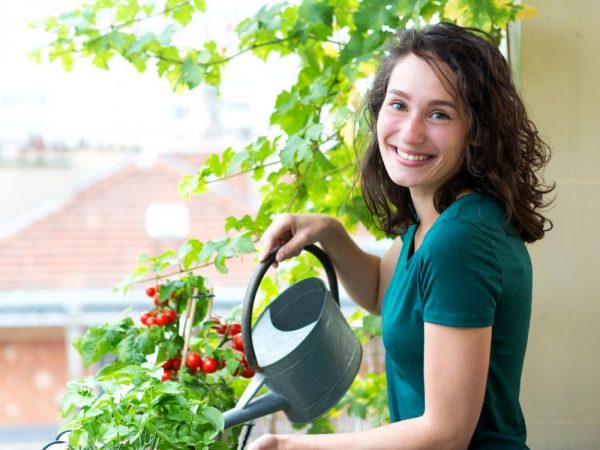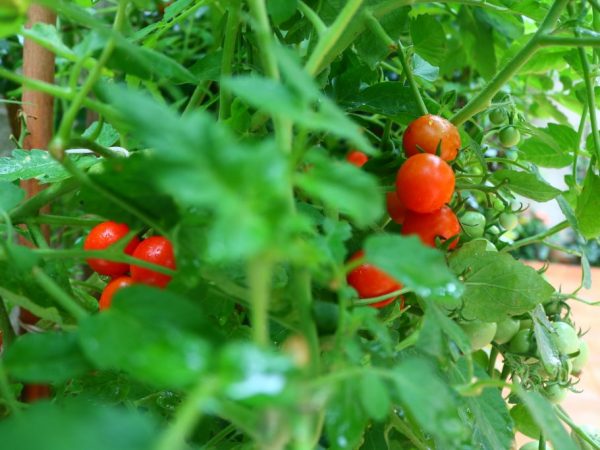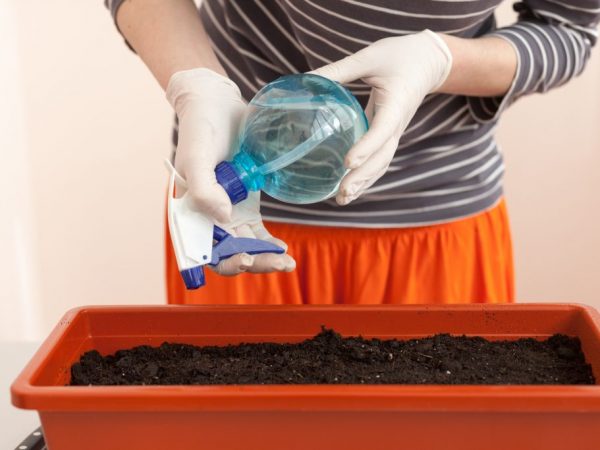Growing tomatoes on the balcony
To grow tomatoes on the balcony, you need to follow the instructions step by step, follow the rules of planting and care. Consider how to grow tomatoes on your balcony.

Growing tomatoes on the balcony
Variety selection
The successful cultivation of tomatoes on the balcony largely depends on the correctly selected variety. Unlike cultivating tomatoes in greenhouses and outdoors, it is recommended to choose compact varieties that can be looked after without much effort.
In addition, for planting balcony tomatoes, it is recommended to make a choice in favor of self-pollinated species, otherwise, during flowering, you will have to pollinate them yourself.
Tomato bush size
Which tomatoes will take root on the balcony? Large tomato bushes in a balcony will not feel comfortable, and this will certainly affect the yield. The most suitable are determinant plants, the height of which does not exceed half a meter.
Balcony tomatoes, small in size, do not have to be tied up and pinched; they should not be pinned.
On the balcony, you can grow tomatoes on trellises; for this, not very branched varieties are chosen, which can also be grown in hanging baskets.
Ripening period
For planting balcony tomatoes, it is recommended to select varieties with an accelerated ripening period, related to ultra-early ripening. The longer the period specified in the instructions for the tomato variety from the moment of the first appearance of tomato seedlings to the first harvest, the better.
Fruiting
For balcony growing tomatoes, it is more advisable to select carpal varieties that bear fruit in whole bunches. Such varieties have a decorative purpose, because they can not only bring crops, but also decorate a home loggia. Clustered mini-tomatoes of various colors with elongated or pear-shaped vegetables fit beautifully into the balcony interior.
Famous balcony varieties
Among the tomatoes for the balcony, a number of varieties are distinguished:
- The balcony miracle is a carp variety with round red vegetables of a pleasant sweetish taste.
- Red caramel is a standard variety with small bushes and oval bright red fruits with a slight sourness.
- Yellow caramel is a high-yielding variety, ripening in clusters, with elongated yellow vegetables, with a dense skin and taste, shaded with light fruity notes.
- Cranberries in sugar - a variety of tomatoes with high yields, small red fruits ripening in clusters, characterized by a sweet-sour rich taste.
- The Golden Drop is an indeterminate variety, well suited for cultivation on a balcony loggia in hanging baskets, has pear-shaped fruits, bright yellow in color with a light fruity taste.
- The yellow date is a tomato species with moderately tall bushes, suitable for growing on a balcony on trellis supports, it has elongated oval-shaped vegetables with a sweet taste, ripening in clusters.
- The garden pearl is a decoratively beautiful tomato ampelous variety with long cascading vines, on which cherry vegetables of bright pink color with a sweet taste ripen.
- Cherry fingers are a tomato variety for balcony cultivation in a hanging basket with compactly folded bushes and very sweet, elongated, bright red fruits.
Equipping a balcony loggia

Much depends on the location of the loggia
Tomatoes are grown on the balcony, taking into account where the loggia is located. It will be better if it faces the south-east or south-west side. The balcony loggia located on the south side requires shading in the hot season, and rooms with a northern direction, where the sun's rays fall no more than 3 hours a day, are not suitable for growing balcony varieties of tomatoes.
Placing landings
It is recommended to place containers with tomato seedlings as close as possible to the balcony railings or the wall of the loggia, since the walking wind adversely affects the growth of the tomato bush, suspending its development.
Hanging baskets and pots when growing ampelous varieties of tomatoes on the balcony are not hung very high to make it easier to care for them. Tall tomato bushes are attached to trellis supports made of plastic, wood or woven from ropes, placing them as close as possible to a wall protected from drafts.
Tatiana Orlova (Candidate of Agricultural Sciences):
The capacity of the dishes in which the tomato plant will be grown should be at least 3-4 liters for the most weak varieties, 30-35 cm high and at least 7-8 liters for relatively large ones (up to 50 cm).
Vegetable neighbors
Gardeners have adapted to plant mint, oregano, celery and curly parsley next to tomatoes, which not only serve as a decorative addition, but also repel insect pests.
Preparing for landing
Growing tomatoes on the balcony requires fertile soil and easy-to-grow containers.
Soil soil
Balcony tomatoes prefer nutritious light soil with neutral or slightly alkaline acidity. In this case, it is better not to use ready-made soil mixtures that are not particularly rich in nutrients and contain a large amount of peat in their composition.
The most favorable soil consists of turf and humus, mixed in different proportions. To give the soil looseness, peat or sawdust is mixed into it. For fertilization, use granular superphosphate, nitrate, wood ash, potassium sulfate.
One of the following options is also chosen as a soil:
- mixed garden soil, humus and a small amount of peat,
- a mixture of turf soil, compost and ready-made substrate containing peat,
- garden soil diluted with compost and washed river sand.
Tatiana Orlova (Candidate of Agricultural Sciences):
You can buy ready-made garden soil specifically for growing tomatoes. All soil components in it are in optimal proportions. In addition, no fertilizer is required before planting. It is necessary to feed tomato plants as it grows and fructifies.
Capacities
Plastic or wooden boxes are suitable for growing tomatoes on the balcony, which are conveniently placed along the balcony railings or walls.
You can also use individual pots and even cut plastic bottles, which eliminates the subsequent picking process.
Tatiana Orlova (Candidate of Agricultural Sciences):
Containers for growing mature plants must be opaque, because in the light on the walls and soil, green microscopic algae appear, which worsen the condition of the plants.At the bottom of the box or pot, it is imperative to place a drainage from expanded clay or broken brick. The dishes must have a drainage hole to drain excess water.
Seed sowing

Seeds and soil must be prepared before planting
Tomatoes grown on the balcony can be harvested faster if they are planted using the seedling method. Initially, the seeds are treated with drugs that stimulate growth, soaking them for 10-12 hours. To stimulate the germination process, potassium permanganate or a drug called Epin is used. This preliminary preparation helps to increase the germination of tomato seeds.
If you purchased seeds in a specialized store, you can grow tomatoes on the balcony without pretreating the seed material, which is done for the purpose of disinfection.
Sowing seeds begins in March, in rare cases - in winter, in the last days of February. For this, shallow containers with pallets or plastic bottles and pots are filled with prepared soil soil, leaving 1 cm from the edge, the soil is tamped, grooves are cut and tomato seeds are sown in them. Seed material is planted with deepening, sprinkling with a soil layer, then sprayed on top with water at room temperature, covered with a film and placed in a warm place until the first shoots appear.
Initial care
During the period of germination of tomato seeds before the first seedlings appear, watering is carried out once every 5-7 days. When the first leaves appear, they carry out the primary mineral bait, using special mineral compositions for seedlings.
Pick and transfer
At the first true 1-2 leaves that appear, tomato seedlings are dived, and after 14-15 days, the strengthened sprouts are transplanted onto the balcony to a permanent place, having carried out a second mineral dressing before that.
Usually, the process of transplanting to the balcony falls on the first days of May, if the loggia is glazed, and in the first half of June, if the balcony is open.
Seedlings are planted in long boxes at a distance of 30-35 cm from each other so that the growing tomato bushes have enough space to receive light, water and fertilizers. No more than one bush is planted in each container. At the same time, for each tomato bush, at least 4 kg of the same substrate is required in which the seeds germinated. The bottom of the containers is laid out with expanded clay or pebbles.
For greater fertility, ash powder is mixed into the soil.
Young seedlings are moved to new containers along with an earthen clod to protect the root system from accidental damage.
Transplanting seedlings ends with watering with water at room temperature.
Balcony care
Tomato bushes planted in a permanent place of growth are afraid of direct sunlight and stagnation of moisture in the soil, therefore in the first days, while the plant is getting used to new conditions, when caring for plantings, it is important to protect young seedlings with roller blinds or awnings, and water with standing or boiled water watering in the morning and evening hours.
Stepping
Pickling is required for balcony varieties of tomatoes, which are of the indeterminate type and are grown in baskets or on trellis supports. They begin to do this process of breaking off shoots after the appearance of the 3rd flower cluster. When the tomato stem is excessively stretched in height, it is pinched at the point of growth in order to quickly activate the process of ovary formation.
Mineral dressing
After transplanting young seedlings, tomato bushes are no longer fed with mineral compounds, among the components of which there is nitrogen. These fertilizers, including, for example, urea and ammonium nitrate, lead to an active build-up of green mass and stop the process of fruit formation.
Stimulating the appearance of ovaries allows the introduction of fertilizers containing phosphorus and potassium.Tomato bushes are fed with such mineral complexes at least 3 times per season. Mineral compositions can be replaced with natural organic matter and add humus, bird droppings, mullein.
Tatiana Orlova (Candidate of Agricultural Sciences):
In a limited volume of soil, it is very easy to "burn" the root system of plants with fast-acting organic fertilizers. They must be used very carefully for balcony tomatoes, but it is better to use ready-made liquid fertilizers, liquid complex fertilizers, which simultaneously contain an infusion of organic matter and minerals.



